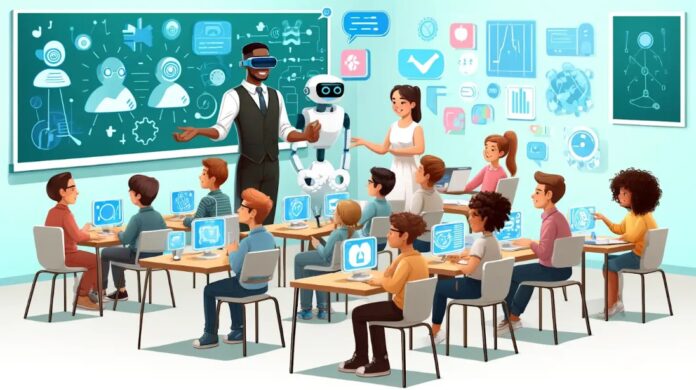Did you know that the first AI program for educational purposes was developed way back in 1970? Fast forward to today, and artificial intelligence is not just a supplementary tool but a fundamental component of what we call Education 4.0.
As we stand at the crossroads of a new era in learning, AI marketing tool unveils the profound changes AI is bringing to educational landscapes globally.
This innovation isn’t confined to high-tech gadgets and sophisticated algorithms; it’s about creating a more inclusive, personalized, and efficient learning environment.
From automated help in lesson planning to tailored tutoring sessions, AI’s role in education is not just transformative—it is revolutionary.
Let’s dive into how AI is setting the stage for the future of education, promising a smarter, more inclusive world for learners everywhere.
The Promise of AI in Educational Enhancement
Artificial Intelligence is turning the page on traditional educational methods and introducing a chapter that seems straight out of a science fiction novel. Yet, this isn’t fiction—it’s the very real, rapidly unfolding future of education.
Let’s delve into how AI is not only promising but actively delivering significant enhancements in the realm of learning.
AI: A Game Changer in Classroom Dynamics
The traditional classroom, with its one-size-fits-all teaching approach, often misses the mark in addressing the unique needs of each student. Enter AI, a technology poised to tailor the educational experience to the individual.
Imagine a world where AI systems analyze the learning patterns and difficulties of each student, adapting the content to fit their specific needs and pace. This level of personalization ensures that no student is left behind, making education more inclusive and effective.
Breaking New Ground in Educational Accessibility
AI is also a powerful ally in breaking down the barriers to education that many students face worldwide. With AI-powered platforms, resources can be digitized and made accessible to anyone with an internet connection.
This means that students in remote or underprivileged areas can access the same quality of education as those in well-funded urban schools. By democratizing education, AI is leveling the playing field and opening up opportunities for all learners, regardless of their geographical or economic circumstances.
Enhancing Teacher Support with Intelligent Tools
Teachers are the backbone of the educational system, but they often grapple with large class sizes and diverse student needs. AI can lighten this load by taking over some of the administrative tasks such as grading and scheduling.
More importantly, AI can provide teachers with real-time insights into student performance, enabling them to intervene effectively and personalize their instructional strategies. This not only enhances the learning process but also allows teachers to focus on what they do best: teaching.
Fostering a Data-Driven Educational Environment
In an AI-enhanced educational setting, decisions are no longer based on hunches or one-size-fits-all solutions. Instead, they are driven by data.
AI tools collect and analyze vast amounts of information on student engagement and achievement, providing educators with actionable insights. This data-driven approach helps in refining teaching methods and educational strategies, ensuring that they are effective and scientifically sound.
Enhancing Teaching Dynamics through AI
As we navigate through the era of digital transformation, the role of AI in enhancing teaching dynamics is becoming increasingly significant.
This technology is not just a tool for educators; it’s a partner that reshapes the way teaching is delivered, making it more effective, engaging, and inclusive. Here’s how AI is contributing to the evolution of teaching methods and the enhancement of educational environments.
Augmenting the Teacher’s Role with AI
The most profound impact of AI in the classroom is its ability to augment the teacher’s role. By taking over repetitive and time-consuming tasks, AI frees up teachers to focus on what they do best: teaching.
For instance, AI-powered systems can automate grading, manage classroom schedules, and even track student attendance. This shift allows teachers to dedicate more time to interactive and personalized teaching, ultimately fostering a more engaging learning environment for students.
Beyond Automation – Supporting Human-Centric Teaching
While AI excels at handling administrative tasks, its capabilities extend far beyond automation. AI technologies can also provide teachers with detailed analytics about each student’s learning progress and needs.
This information is crucial as it enables teachers to tailor their instructional methods to better suit individual students, enhancing the learning experience.
Imagine a classroom where AI tools are used to identify students who might be struggling with a specific concept. Teachers can then intervene more effectively, offering targeted support to ensure that every student understands the material.
Moreover, AI can suggest diverse teaching strategies based on the collected data, which helps in addressing the varied learning styles present in any classroom.
Creating a Richer Learning Experience
AI doesn’t just simplify tasks; it enriches the learning experience. By integrating AI tools into the curriculum, educators can create dynamic learning materials that adapt to the pace and level of each student.
For example, AI-driven simulations and interactive modules can make learning more immersive and fun, especially for complex subjects like science and mathematics.
These tools not only maintain student interest but also deepen their understanding by allowing them to see the practical application of theoretical knowledge.
This hands-on approach, facilitated by AI, is proving to be more effective in retaining student interest and enhancing their learning outcomes.
Revolutionizing Assessments and Analytics
In the journey to redefine education through technology, artificial intelligence (AI) stands out not only as a teacher’s aide but also as a revolutionary force in assessments and analytics.
This transformative tech is reshaping how we evaluate student learning and understand educational effectiveness, promising a future where insights and precision guide the educational process.
AI-Driven Assessment Tools
Gone are the days of one-size-fits-all testing. With AI-driven assessment tools, educators can now administer tests that adapt in real-time to the test-taker’s ability level.
These intelligent systems adjust the difficulty of questions based on the student’s previous answers, making the assessment process not only more fair but also more accurate in measuring a student’s true capabilities.
Furthermore, AI can automate the scoring of these assessments, even for complex answers such as essays. This not only speeds up the feedback loop but ensures consistency in grading, a task that can vary widely between human graders.
Teachers can then use this data to provide targeted feedback to students, helping them improve in specific areas that the AI has identified as weaknesses.
Facilitating Tailored Educational Strategies
The power of AI in education extends into the realm of analytics. By collecting and analyzing vast amounts of data on student interactions and performance, AI tools can offer unprecedented insights into learning patterns.
This capability allows educators to pinpoint not just what students are struggling with, but why and how to best address these challenges.
For instance, if AI analytics reveal that a significant portion of students are stumbling over a particular concept, the curriculum can be adjusted to provide more detailed explanations or additional resources.
Alternatively, AI can suggest grouping students by learning style or level for certain activities, enhancing the effectiveness of peer learning and instructional time.
Enhancing the Feedback Loop
With AI’s capacity for real-time data analysis, the feedback that students and teachers receive is more immediate and actionable. This quick turnaround is crucial for learning as it allows students to correct mistakes and reinforce understanding while the material is still fresh.
Educators, too, benefit from being able to see the effects of their teaching strategies almost instantly, enabling them to make agile adjustments to improve educational outcomes.
Building a Data-Driven Educational Environment
Imagine a school where every decision made about the curriculum, teaching methods, and even student placement is informed by data. AI makes this possible by providing a continuous stream of analytics that can guide educational choices with precision and insight.
This shift towards a data-driven approach not only makes educational processes more efficient but also more effective, tailored to the unique landscape of each classroom and each learner’s needs.
Bridging the Digital Skills Gap
In a world increasingly driven by technology, the digital skills gap presents a formidable challenge, but also a remarkable opportunity. AI is poised to play a pivotal role in equipping students with the essential skills needed for the future workplace.
Let’s explore how AI is crucial in bridging this gap and ensuring all students are prepared for the digital age.
Preparing Students for a Digital Future
The demand for digital literacy and tech-savvy professionals continues to grow across all sectors. AI in education is stepping up to meet these demands by integrating digital skills training into the classroom.
From elementary schools to universities, AI-powered tools are being used to teach coding, data analytics, and even how to interact with and manage AI technologies themselves.
These tools not only impart technical skills but also foster problem-solving, critical thinking, and creativity—all competencies crucial for success in a digital economy.
By embedding AI in the curriculum, educators can provide a dynamic learning experience that is both engaging and relevant to today’s technological landscape.
Enhancing Access to Technology-Driven Education
AI can dramatically increase access to education, especially in under-resourced areas. Online learning platforms powered by AI bring high-quality educational resources to students regardless of location.
These platforms can adapt to different learning styles and paces, making education more inclusive and personalized than ever before.
Moreover, AI facilitates the widespread dissemination of digital skills through gamified learning and virtual simulations, which are especially effective in engaging younger audiences.
Such innovative approaches ensure that learning digital skills becomes not only accessible but also enjoyable.
Supporting Teachers in Delivering Digital Education
Teachers are at the front lines of education, yet many lack the training necessary to effectively teach digital skills. AI can support educators by providing them with the tools and resources needed to upgrade their teaching methods.
AI-driven professional development courses can help teachers stay ahead of technology trends and understand how best to integrate them into their teaching.
Additionally, AI can offer real-time assistance to teachers, suggesting content adjustments based on student performance data or providing templates for digital skill projects.
This support not only enhances the teacher’s ability to deliver digital education but also ensures that they can confidently lead their students into the digital future.
Fostering a Culture of Continuous Learning
With the rapid pace of technological change, learning cannot stop at graduation. Lifelong learning must be a core part of our educational systems to keep pace with innovation.
AI helps by providing customizable learning modules that individuals can use to continually update their skills throughout their careers.
This approach ensures that everyone—from young students to seasoned professionals—has the resources to learn and adapt to new technologies.
It promotes a culture of continuous learning and adaptability, which are essential in a world where new digital tools and AI advancements are commonplace.
The Road Ahead: AI and Lifelong Digital Learning
As AI continues to evolve and integrate into educational systems, it has the potential to close the digital skills gap significantly.
By providing personalized learning experiences, supporting teachers, and promoting lifelong learning, AI not only prepares students for the challenges of today but also for the opportunities of tomorrow.
Embracing AI in education means more than just teaching with technology—it means preparing for a future that is interconnected, tech-driven, and full of potential.
Personalizing Education with AI
In the rapidly evolving landscape of education, personalization is not just a luxury—it’s becoming a necessity. AI is at the forefront of this transformation, making personalized learning not only possible but also increasingly sophisticated. Here’s how AI is tailor-making education to fit the unique needs of every student.
Tailoring Learning to Individual Needs
Every student learns differently, and AI is perfect for accommodating these individual differences. By analyzing data on students’ learning habits, comprehension speeds, and engagement levels, AI can create customized learning paths for each student.
This personalized approach ensures that faster learners are adequately challenged while those who need more time can proceed at a pace that suits them, all without feeling pressured or left behind.
For example, AI-driven platforms can automatically adjust the difficulty of tasks based on the student’s past performance, ensuring that each assignment is appropriately challenging.
This kind of responsiveness encourages a deeper understanding of material and promotes a more satisfying learning experience that is tailored to individual capabilities.
Enhancing Engagement with Customized Content
Engagement is key to effective learning, and AI excels at keeping students engaged. By leveraging AI, educators can deliver content that resonates more deeply with students by aligning with their interests and learning styles.
Whether it’s through interactive simulations for visual learners or story-driven problems for verbal learners, AI helps in crafting content that is not only educational but also compelling.
Moreover, AI can integrate real-world issues into the curriculum, making learning more relevant to students’ lives and future careers.
This relevance boosts motivation and can significantly enhance the educational impact, preparing students not just for exams, but for real-life challenges.
Supporting Diverse Learning Environments
AI’s ability to personalize education is a boon for inclusivity. Students with disabilities or those from non-traditional learning backgrounds can benefit immensely from AI’s tailored approaches.
For instance, AI tools can provide augmented learning experiences for students with visual or auditory impairments, ensuring that they receive the same quality of education in a format that is accessible to them.
Additionally, AI can help language learners by adapting instructions to their proficiency level, thereby smoothing their integration into mainstream education systems. This level of personalization not only supports diverse educational needs but also promotes an inclusive learning environment where every student has the opportunity to succeed.
Continuous Improvement Through AI Feedback
One of the most powerful aspects of AI in education is its ability to continually learn and improve. AI systems gather feedback from their interactions with students, allowing them to constantly refine and optimize the learning experiences they provide.
This continuous improvement cycle ensures that the educational tools not only remain effective but become even more so over time.
As AI technologies learn more about student preferences and educational outcomes, they become better equipped to deliver highly effective personalized learning experiences.
This ongoing refinement is key to developing educational practices that can adapt and evolve with the needs of students and the demands of the job market.
Challenges and Considerations in Implementing AI in Education
While the integration of AI into education offers transformative potential, it is not without its challenges. Understanding these obstacles and giving thoughtful consideration to how we address them is essential for harnessing AI’s full capabilities responsibly and effectively.
Here are some of the key challenges and considerations that must be navigated as we incorporate AI into educational frameworks.
Ensuring Equitable Access
One of the foremost challenges in implementing AI in education is ensuring that these technologies are accessible to all students, regardless of their socioeconomic background.
There is a significant risk that AI could exacerbate existing disparities in education if only affluent schools can afford these advanced technologies. To avoid deepening the digital divide, it’s crucial to implement policies that help subsidize AI tools in underfunded schools and provide robust internet access to underserved communities.
Balancing AI and Human Interaction
AI can automate tasks and personalize learning experiences, but it should not replace the essential human elements that are fundamental to education. The empathy, understanding, and interpersonal skills of human teachers are irreplaceable.
Striking the right balance between using AI to enhance educational outcomes while preserving the human touch is critical. It’s important that we use AI as a tool to support educators, not as a substitute that could lead to a depersonalized education system.
Protecting Student Privacy
The use of AI in education involves the collection and analysis of large amounts of data, which raises significant privacy concerns. Ensuring the security of student data and protecting their privacy must be a priority.
Educational institutions need to implement stringent data protection measures and develop transparent policies regarding the use of student information. Additionally, there should be clear regulations governing data handling by AI systems to prevent misuse and protect student confidentiality.
Addressing Bias in AI Algorithms
AI systems are only as unbiased as the data used to train them. If this data contains implicit biases, the AI’s decisions and learning recommendations can perpetuate these biases.
To mitigate this, it’s essential to use diverse data sets in training AI models and continuously monitor and adjust algorithms to ensure they remain fair and impartial. This also includes cultural and linguistic inclusiveness in AI programming to cater to a diverse student population.
Managing Implementation Costs
Implementing AI solutions in education can be costly, especially when considering the need for ongoing maintenance, updates, and training for educators to effectively use these technologies.
Schools must consider not only the initial investment in AI tools but also the long-term financial commitment required to sustain their use. Effective budget management and perhaps financial aid from governmental and non-profit organizations will be critical to the widespread adoption of AI in education.
Fostering Acceptance and Collaboration
The introduction of any new technology can meet with resistance from those it aims to help. Building trust and acceptance among educators, students, and parents involves clear communication about the benefits and limitations of AI in education.
Additionally, fostering a collaborative environment where teachers and tech developers work together to tailor AI tools to classroom needs can facilitate smoother integration and greater efficacy.
The Future of AI in Education
As we peer into the horizon of educational technology, it’s clear that artificial intelligence (AI) will play a pivotal role in shaping the future of education.
This isn’t just about using new tools in the classroom; it’s about fundamentally rethinking how education is delivered to prepare students for an increasingly complex world.
Let’s explore the potential developments and the impact AI might have on the educational landscape.
Revolutionizing Learning Environments
The classrooms of the future will likely be hybrid spaces where digital and physical environments merge to enhance the learning experience.
AI-driven virtual reality (VR) and augmented reality (AR) could become standard tools, providing students with immersive learning experiences that were once the stuff of imagination.
From walking through historical sites to conducting complex scientific experiments in controlled virtual spaces, AI will make experiential learning accessible to every student.
Customizing Education at Scale
One of AI’s most significant promises is its ability to personalize learning at an unprecedented scale.
Imagine a system where every lesson is tailored not just to a student’s learning style but also to their current mood and energy levels, optimizing the timing and delivery of content to maximize learning efficiency.
AI could customize educational pathways so that they truly fit the needs and aspirations of each student, adapting in real-time as students evolve.
Expanding Access to Global Classrooms
AI will also break down geographical barriers, offering every student a “global classroom” experience.
This means that students in different parts of the world can not only access high-quality education materials but also participate in global learning communities without ever leaving their hometowns.
Through AI, educators and students can connect across borders, fostering a truly international educational experience.
Facilitating Lifelong Learning
The future of education with AI extends beyond traditional schooling. As career trajectories become more dynamic, continuous learning will be essential, and AI will facilitate this by providing personalized, on-demand learning experiences for all ages.
Whether it’s upskilling for a new job or exploring a personal interest, AI will provide the tools for lifelong learning, keeping individuals competitive and informed throughout their lives.
Read also: How to Choose the Best Artificial Jewellery
Predictive Analytics and Improved Outcomes
With the power of predictive analytics, AI will not only understand where students are but anticipate where they could go.
This could mean identifying students who might benefit from extra help before they fall behind or recognizing those who are ready for more challenging material.
By predicting educational outcomes, AI can help educators proactively manage the learning journey, ensuring that every student has the best chance to succeed.
Ethical Considerations and AI Governance
As we embrace these advancements, the ethical implications of AI in education will come to the forefront. Ensuring that AI is used responsibly and that its benefits are equitably distributed will require robust governance structures.
This involves setting standards for ethical AI use, protecting student data privacy, and ensuring that AI tools are free from bias.
Embracing the AI-Enhanced Educational Future
The integration of AI into education promises to not only enhance how we teach and learn but also to expand what education can achieve.
As AI technology continues to develop, its integration into educational systems around the world will undoubtedly encounter challenges, but the potential benefits are immense.
By embracing AI, we can look forward to an educational future that is more inclusive, effective, and adaptive to the needs of students everywhere.
The journey toward AI-enhanced education is just beginning, and it’s an exciting time for educators, students, and technologists alike.



